Kidderminster, Worcestershire
Up to 1834
The first mention of a workhouse in Kidderminster was in 1753 when it stood
in Vicar Street. By the 1770s, it could house up to 70 inmates. In about1784,
a larger establishment was built on the nearby Vicarage
meadow, approximately where Oxford Street is today. Increasing demand for places
required the construction in 1816 of a further new
workhouse was erected in Hornes’s Field, now Broad Street.
Bewdley's workhouse had its origins in November 1736 when the Mayor and Burgesses of the town decided to erect a workhouse for the maintaining the poor. They donated £206 6s towards the cost of the building which was erected on a rented site, at what is now 64 High Street. When the workhouse opened in 1737, a Governor and Matron were appointed at a salary of 15s.4d. per month. By the 1770s, it held up to 80 paupers.
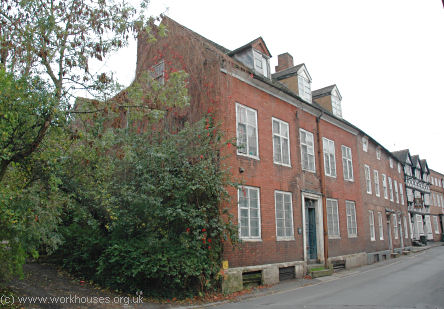
Bewdley former parish workhouse, 2006.
© Peter Higginbotham.
The Bewdley Overseers' accounts record the payment of a doctor to visit the sick in the workhouse, and extra food for them. In the 1790s, such items included "Wine for the Sick 10d.", "Ale and Cakes for the Sick at times 4-2d", and "Cakes and Wigs [spiced buns] for the Sick 3d.". Those who died in the workhouse had their funeral expenses paid, including the purchase of a coffin and the payment of coffin-bearers. Other entries in the accounts included:
| A pair of Flatt Irons | 4 - 6d. |
| Mr. Edwd Evans for his former Engagement and disappointment. | £10 - 0 - 0d. |
| A water cask and 2 hoops | 4 - 8d. |
| Chamberpotts | 6d. |
| For 12 Spinning Wheels | £4 - 11 - 6d. |
| Thomas Hammonds for 23 days work white-washing and painting | £1 - 14 -6d. |
| The Months Milk | 6 - 0d. |
| 2 Pewter porringers | 10d. |
| 17 Trenchers, A Ladle, 2 pigons [small vessels], a rolling pin and wooden ware | 5 - 8d. |
| Lost by 4 bad half Crowns Recd from the Overseers last year | 10 - 0d. |
| On Tun of Coles | 10 - 6d. |
| House and Window Tax | 17 - 4d. |
| From Philip Pound in part of 16 guineas for a bastd child sworn on him by Sarah Pardoe | £10 - 10 - 0d. |
Chaddesley Corbett had a workhouse dating from 1795 situated at the east side of its main street. The building, now known as Harkaway House, was substantially rebuilt in the 1960s.
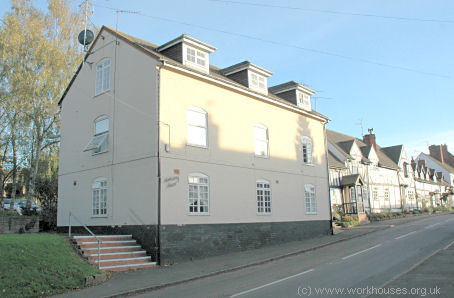
Chaddesley Corbett former parish workhouse, 2006.
© Peter Higginbotham.
Pigot's Directory of 1828-9 records that Stourport's workhouse was at Lower Mitton, with Joseph Partridge as its governor.
After 1834
Kidderminster Poor Law Union was formed on 14th October 1836. Its operation was overseen by an elected Board of Guardians, 21 in number, representing its 13 constituent parishes as listed below (figures in brackets indicate numbers of Guardians if more than one):
County of Worcester:
Bewdley (2), Chaddesley Corbett, Churchill, Kidderminster Borough (5), Kidderminster Foreign (2), Lower Mitton (2), Ribbesford, Rushock, Stone, Wolverley (2).
County of Stafford: Broome [Broom], Upper Arley.
County of Salop: Dowles.
Later Additions: Stourport (from 1928), Wribbenhall (from 1901).
The population falling within the Union at the 1831 census had been 29,908 with parishes ranging in size from Dowles (population 62) to Kidderminster Borough (14,981). The average annual poor-rate expenditure for the period 1833-35 had been £11,733 or 7s.10d. per head.
A new union workhouse was erected in 1836-8 at the east side of Sutton Road in Kidderminster. It was designed by William Knight and J Nettleship. The Poor Law Commissioners authorised an expenditure of £5,650 on construction of the building which was to accommodate 400. It broadly followed the model cruciform plan published by the Commissioners in 1835. Additions in 1884 included a 66-bed men's hospital, a 50-bed women's hospital, a school, a bakery, a brewery, and a boiler-house. In 1889, an adjacent inn called the Tap House was purchased by the Guardians, who demolished it and added the ground to the workhouse site. The workhouse location and layout are shown of the 1902 map below.
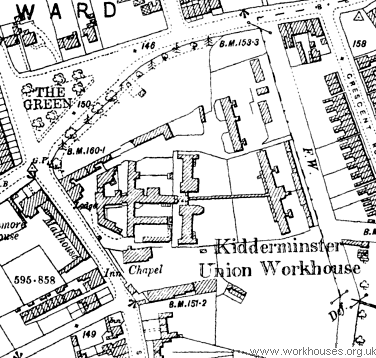
Kidderminster workhouse site, 1921.
The only surviving buildings are now (2007) an entrance lodge and vagrants' block at the west of the site, erected in 1874 to a design by local architect JT Meredith. The ground floor contained a waiting area, interview room, porter's day room with adjacent bedroom, bread room and overseers' room. Stairs led to the Guardians' board room on the first floor with a clerk's room and retiring room for the use of the Guardians. They had a separate entrance and stairs leading directly to the board room. At the rear were vagrant wards, now demolished apart from a bathroom linked to the main block. The male vagrants' accommodation included nine sleeping cells measuring 10 feet by four feet, and nine labour cells facing them across a passageway. There was also a double room and three single rooms for women. The labour cells were used for stone-breaking. Rocks were broken up until the pieces were small enough to pass through a grille to the stone-yard outside.
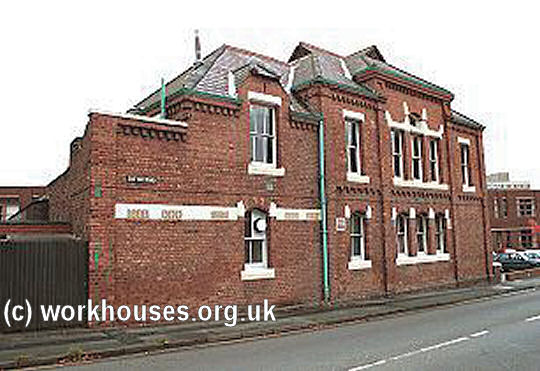
Kidderminster entrance lodge from the north-west, 2000.
© Peter Higginbotham.
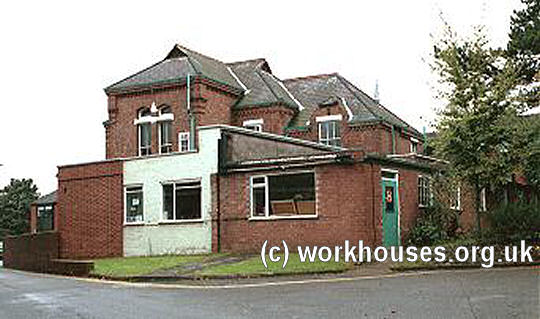
Kidderminster entrance lodge from the north-east, 2000.
© Peter Higginbotham.
In 1840, the Ten Towns' Messenger carried a story concerning the alleged activities of the workhouse porter, John Stokes
In 1865, a new chapel was built at the south of the workhouse, to the designs of W.J. Hopkins, the Worcester Diocesan Architect. It was built of red brick with stone dressings and in the early decorated style. It could hold 222 adults and 50 children, and its cost was about £700.
The former workhouse site later became Kidderminster General Hospital. In 2023, plans were announced to convert the disused entrance block into flats.
Children's Home
From around 1915, the union leased a property known as Sunnyside in Franche Road for use as a children's home. It could house 40 children. The property is now in private residential use.
Staff
Inmates
Records
Note: many repositories impose a closure period of up to 100 years for records identifying individuals. Before travelling a long distance, always check that the records you want to consult will be available.
- Worcestershire Archive and Archaeology Service, The Hive, Sawmill Walk, The Butts, Worcester, WR1 3PB. Holdings include: Guardians' minute books (1836-1928); Admissions and discharges (1904-31); Deaths register (1866-84, 1895-1919); etc.
Bibliography
- Beves, M.I.K. Bewdley Workhouse in Essays Toward a History of Bewdley (1975?) [A rather jumbled mixture of pre- and post-1834 material.]
Links
- The union's early correspondence with the central poor-law authorities is online on the TNA website .
Acknowledgment
- Thanks to Chris Pickford for information on the workhouse chapel.
Unless otherwise indicated, this page () is copyright Peter Higginbotham. Contents may not be reproduced without permission.


